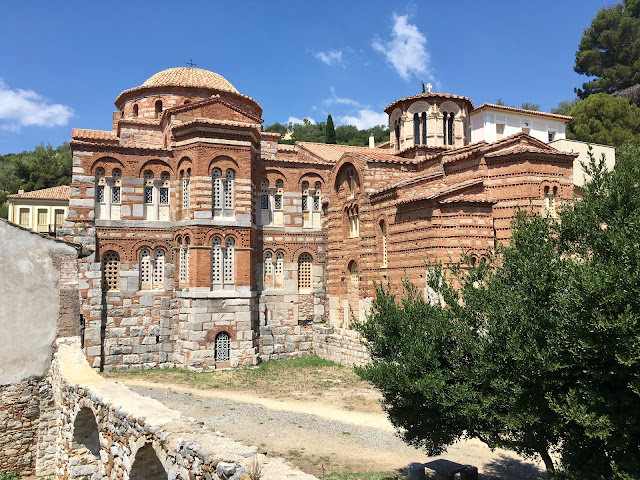While checking out of our Delphi hotel, the owner asked where we were going next. He recommended we stop at Housias Loukas Monastery, on our way back to the Athens area. We did just that, and Hosias Loukas impressed us! It is situated in a rural agricultural area on the slopes of Mount Helicon, about 35 km from Delphi, and surrounded by thousands of acres of olive trees. It was founded in the early 10th century AD by the hermit, Housais Loukas. St. Loukas was a hermit who died on 7 February 953. It is believed the Monastery’s Church of Panagia was constructed from 959-963.
The main shrine of the monastery is the tomb of St. Loukas, located in the Katholikon, dated at 1011-12. The Katholikon is the earliest domed-octagon church and it contains the best preserved complex of mosaics from the period of the Macedonian Renaissance. They are stunning with tiny pieces of colored stone and metals, the size of a small finger nail, and covering ceilings and walls of the church. A crypt is underneath the church, and contains frescoes considered “the most complete program of wall paintings surviving from the Middle Byzantine period. They were mostly painted soon after 1048 AD. The Katholikon is connected to a second church, the most ancient one, the Church of the Virgin Mary, dated to the middle of the 10th century, and dedicated to Housias Loukas. It is considered a masterpiece of Byzantine architecture. Housias Loukas Monastery is a UNESCO World Heritage Site.
The main shrine of the monastery is the tomb of St. Loukas, located in the Katholikon, dated at 1011-12. The Katholikon is the earliest domed-octagon church and it contains the best preserved complex of mosaics from the period of the Macedonian Renaissance. They are stunning with tiny pieces of colored stone and metals, the size of a small finger nail, and covering ceilings and walls of the church. A crypt is underneath the church, and contains frescoes considered “the most complete program of wall paintings surviving from the Middle Byzantine period. They were mostly painted soon after 1048 AD. The Katholikon is connected to a second church, the most ancient one, the Church of the Virgin Mary, dated to the middle of the 10th century, and dedicated to Housias Loukas. It is considered a masterpiece of Byzantine architecture. Housias Loukas Monastery is a UNESCO World Heritage Site.












